COSPAR ID 2011-053A Mission status Retired, on orbit Orbital period 1.5 hours Perigee 363,000 m | Crew 3 Mass 8,506 kg Apogee 381,000 m | |
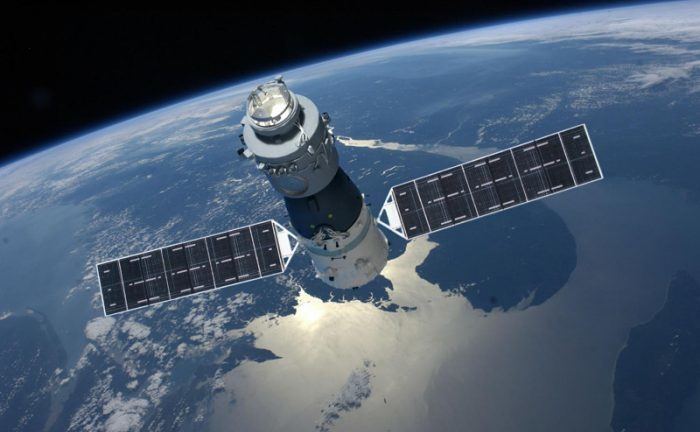 | ||
Launch 29 September 2011 at 21:16:03.507 CST Similar Shenzhou, Tiangong‑2, Chang'e 2, Chinese large modular s, Tiangong program | ||
Tiangong-1 (Chinese: 天宫一号; pinyin: Tiāngōng yīhào; literally: "Heavenly Palace 1") is China's first prototype space station, serving as both a manned laboratory and an experimental testbed to demonstrate orbital rendezvous and docking capabilities. Launched unmanned aboard a Long March 2F/G rocket on 29 September 2011, it is the first operational component of the Tiangong program, which aims to place a larger, modular station into orbit by 2023. Tiangong-1 was initially projected to be deorbited in 2013, to be replaced over the following decade by the larger Tiangong-2 and Tiangong-3 modules, but as of October 2016 it was still aloft, though in a decaying orbit.
Contents
- Design and development
- Structure
- Onboard facilities
- Background
- Launch
- Orbital transfers and testing
- Autonomous orbital docking
- Preparations
- Shenzhou 9
- Shenzhou 10
- Post mission era
- Future development
- References
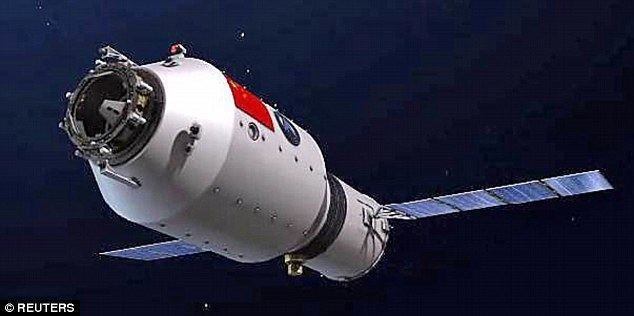
Tiangong-1 was visited by a series of Shenzhou spacecraft during its two-year operational lifetime. The first of these, the unmanned Shenzhou 8, successfully docked with the module in November 2011, while the manned Shenzhou 9 mission docked in June 2012. A third and final mission to Tiangong-1, the manned Shenzhou 10, docked in June 2013. The manned missions to Tiangong-1 were notable for including China's first female astronauts, Liu Yang and Wang Yaping.
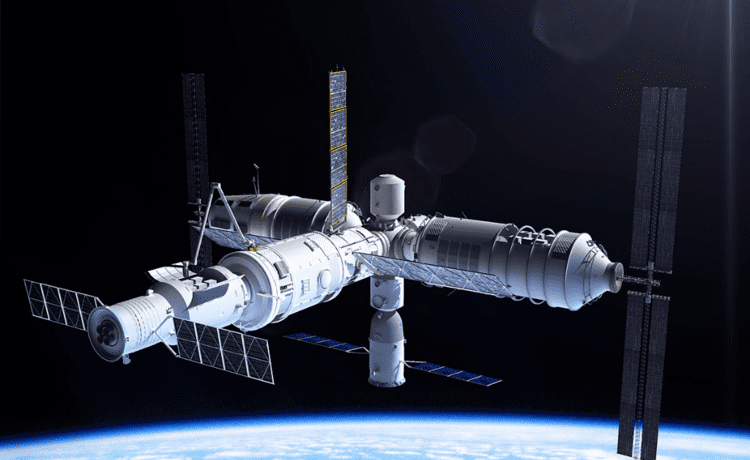
On 21 March 2016, after two years of extended lifespan, the Space Engineering Office announced that Tiangong-1 had officially ended its service. They went on to state that the telemetry link with Tiangong-1 had been lost. A couple of months later, amateur satellite trackers watching Tiangong-1 began to speculate that China's space agency had lost control of the station. In September, after conceding they had lost control over the station, officials announced that the station would re-enter and burn up in the atmosphere late in 2017.
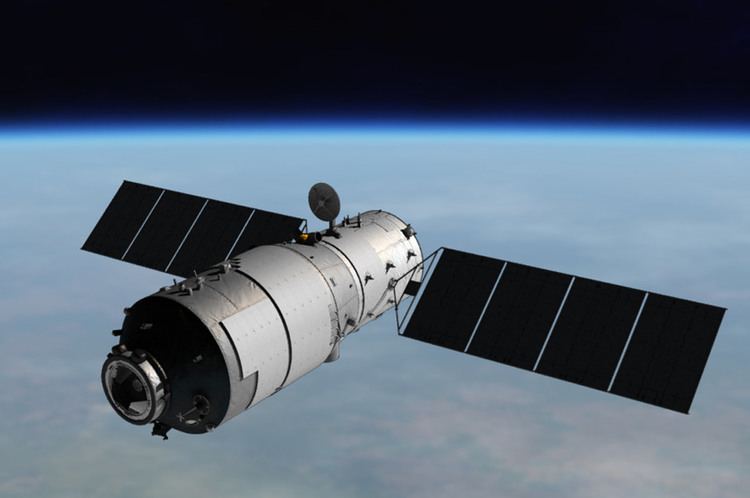
Design and development
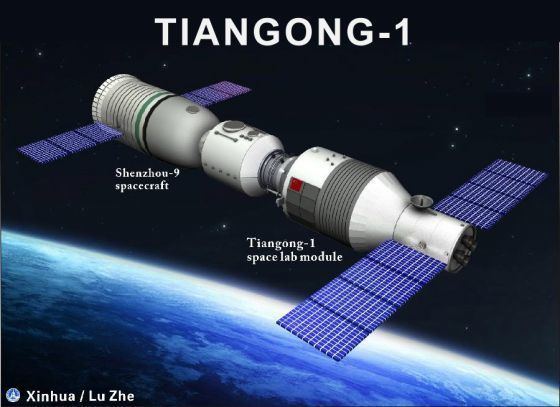
The China National Space Administration (CNSA) designed Tiangong- 1 as an 8.5-tonne (19,000 lb) "space-laboratory module", capable of supporting the docking of manned and autonomous spacecraft. In 2008, the China Manned Space Engineering Office (CMSEO) released a brief description of Tiangong-1, along with its larger successor modules, Tiangong-2 and Tiangong-3. A model of the space station was revealed in the Chinese Lunar New Year celebration program on CCTV on 25 January 2009.
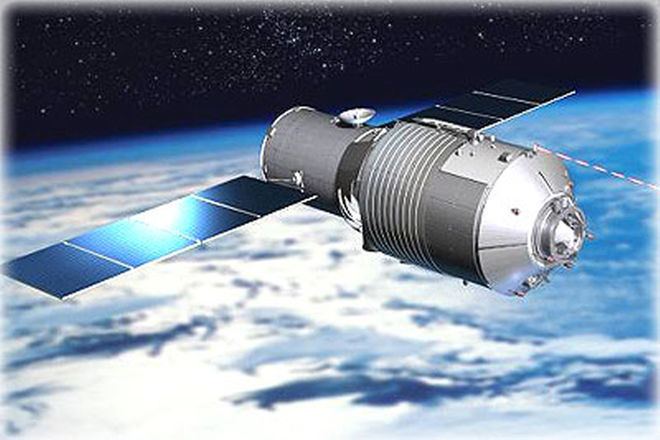
On 29 September 2008, Zhāng Jiànqǐ (张建启), vice-director of the CMSEO, declared in an interview with China Central Television (CCTV) that Tiangong-1 would be launched in 2010 or 2011. Xinhua later stated that Tiangong-1 would be launched in late 2010, and declared that the renovation of ground equipment was in progress. However, the Launch did not ultimately take place until 2011.

By mid-2011, the construction of Tiangong-1 was complete, and its systems and thermal properties were undergoing testing. Testing was also conducted on the Long March 2F Carrier rocket on which Tiangong-1 would be launched; technicians undertook particularly extensive safety tests on the rocket in August and September 2011, following the launch failure of a Long March 2C rocket on 18 August.
Structure
Tiangong-1 has a pressurised habitable volume of approximately 15 cubic metres (530 cu ft), and uses passive APAS-type docking connectors. Structurally, Tiangong-1 is divided into two primary sections: a resource module, which mounts its solar panels and propulsion systems, and a larger, habitable experimental module.
Onboard facilities
Tiangong-1's experimental module is equipped with exercise gear and two sleep stations. The interior walls of the spacecraft have a two-color paint scheme – one color representative of the ground, and the other representative of the sky. This is intended to help the astronauts maintain their orientation in zero gravity. High-resolution interior cameras allow manned missions to be closely monitored from the ground, and the two sleep stations have individual lighting controls. Toilet facilities and cooking equipment for the manned missions are provided by the docked Shenzhou spacecraft, rather than being integrated into the Tiangong module itself. Similarly, one member of the module's three-person crew sleeps in the Shenzhou spacecraft, preventing overcrowding.
Background
Tiangong-1 was originally intended to be launched in August 2011, and was delivered to the Jiuquan Satellite Launch Center on 23 July, successfully passing a launch rehearsal test on 17 August. However, following the failed launch of a Long March 2C rocket in August 2011, the launch was postponed. Following an investigation into the August launch failure, Tiangong-1's launch was rescheduled for late September 2011, partly to coincide with the Chinese National Day on 1 October.
Launch
On 20 September 2011, the spacecraft was again rolled out to Pad 1 of the South Launch Site at Jiuquan in preparation for the rescheduled launch attempt. The launch occurred at 13:16 UTC on 29 September, successfully placing Tiangong-1 into low Earth orbit. Chinese television broadcast the launch animation accompanied by an instrumental version of the American patriotic song America the Beautiful, a choice of music for which it later offered no explanation.
Orbital transfers and testing
On 2 October 2011, Tiangong-1 completed the second of two orbital transfer maneuvers, reaching an apogee altitude of 362 kilometres (225 mi). This was the precursor to a week-long program of orbital testing, conducted from the Beijing Aerospace Command and Control Center, to prepare the module for future orbital docking operations. On 10 October, Tiangong-1 released its first orbital photo, showing a view of its outer hull and satellite relay antenna.
Autonomous orbital docking
The unmanned Shenzhou 8 mission successfully docked with Tiangong-1 on 2 November 2011 GMT, marking China's first orbital docking. Shenzhou 8 undocked from Tiangong-1 on 14 November, before successfully completing a second rendezvous and docking, thus testing the reusability of the docking system. Shenzhou 8 deorbited on 17 November 2011, and landed intact in Siziwang Banner in Inner Mongolia. After the mission, the CNSA reported that Tiangong-1's systems were in optimal condition.
Preparations
In December 2011, the Tiangong-1 module began automated internal checks for toxic gas, to ensure that its interior would be safe for astronauts to enter. In January 2012, reports emerged alleging that the American X-37B robotic spaceplane was shadowing Tiangong-1 for surveillance purposes. However, former United States Air Force orbital analyst Brian Weeden later refuted this claim, emphasizing that the X-37B occupied a different orbit from Tiangong-1, and would not be able to closely observe the module.
Shenzhou 9
In March 2012, it was reported that China had finished the initial crew selection for the Shenzhou 9 mission. Niu Hongguang, the deputy chief commander of the China Manned Space Engineering Project, stated that Shenzhou 9 would dock with Tiangong-1 before August 2012. The Shenzhou 9 spacecraft was delivered to Jiuquan Satellite Launch Center for launch preparations on 9 April 2012, while its Long March 2F carrier rocket arrived a month later on 9 May.
Shenzhou 9 launched successfully on 16 June 2012, carrying with it China's first female astronaut, Liu Yang. The spacecraft docked with Tiangong-1 on 18 June 2012 at 14:07 Beijing time (06:07 GMT; 07:07 BST). After about three hours, when the air pressures inside the two vessels were equalized, mission commander Jing Haipeng entered Tiangong-1. The first docking was entirely computer-controlled, without input from the three astronauts; a second, crew-guided docking was successfully conducted on 24 June 2012 at 12:42 Beijing time. Shenzhou 9 landed safely in Inner Mongolia on 29 June 2012. In August 2012, Shenzhou 9's crew travelled to Hong Kong to discuss their mission with university students.
Shenzhou 10
The manned Shenzhou 10 spacecraft, the final Shenzhou mission to rendezvous with Tiangong-1 before its deorbit, was launched on 11 June 2013. The launch of Shenzhou 10 was originally planned for earlier in the year, but was delayed to allow the mission to incorporate more complex scientific experiments. The mission's crew included China's second female astronaut, Wang Yaping. Shenzhou 10 docked successfully with Tiangong-1 on 13 June.
On 15 June 2013, the Shenzhou 10 crew completed China's first orbital maintenance operation, replacing Tiangong-1's interior cladding. Additional maintenance work was conducted on the space station's seal rings. On 20 June, Wang Yaping delivered a remote video lecture from orbit to students across China, demonstrating physics in microgravity with her colleagues. On 24 June, CPC general secretary Xi Jinping contacted the astronauts via remote video link to congratulate them. After a series of successful docking tests, Shenzhou 10 undocked and returned safely to Earth on 26 June 2013. With a duration of 15 days, Shenzhou 10 was China's longest manned space mission to date.
Post-mission era
The Tiangong-1 was launched September 2011 with an intended two year service span. After the last crew departed the module in June 2013 it was put into sleep mode and it was intended that it would remain in orbit for some time, allowing China to collect data on the longevity of key components before being commanded to gradually re-enter the atmosphere. On 21 March 2016 the Manned Space Engineering Office announced that they had disabled data service since the space station had operated two and half years longer than its intended two year service plan. According to the office, the space laboratory is under continued and close monitoring until it finally burns up in the earth atmosphere. Its orbit will descend gradually in the coming months, and the space laboratory will eventually be destroyed by heat in Earth's atmosphere around the end of 2017. Harvard astrophysicist Jonathan McDowell, among others, has noted that parts of the craft such as the rocket engines are probably too dense to be burnt up upon re-entry and may result in chunks of debris up 100 kg in weight falling to the Earth's surface, with little possibility of predicting where they may crash.
Future development
Tiangong-1 was not designed nor planned to be a permanent orbital station; rather, it is intended as a testbed for key technologies that will be used in China's large modular space station, which is planned for launch in 2023. Furthermore, modified versions of Tiangong-1, dubbed Tianzhou, will be used as robotic cargo spacecraft to resupply this station. The launch Mass of the Tianzhou cargo spacecraft is expected to be around 13 metric tons (29,000 lb), with a payload of about 6 metric tons (13,000 lb).
